Current Researches on Plants Having Antidiabetic Potential: An Overview
Banshidhar Behera1* and Deepmala Yadav2
1Department of Dravyaguna, Gaur Brahman Ayurvedic College, Rohtak, Haryana- 124001. India
2Department of Kaumabhritya, MSM Institute of Ayurveda, Khanpur, Sonepat, Haryana-131305, India
- *Corresponding Author:
- Banshidhar Behera
Department of Dravyaguna, Gaur Brahman Ayurvedic College, Rohtak, Haryana- 124001. India
Mobile: +91 9414458895
Received date: 17 March 2013 Accepted date: 04 April 2013
Visit for more related articles at Research & Reviews: Journal of Botanical Sciences
Abstract
Diabetes mellitus is a major threat to global public health as the world wide incidences rising day by day and now emerging as global epidemic affecting approximately 285 million people worldwide that will increase to 439 million by 2030. International Diabetic Federation (IDF) has estimated that by 2025 every fifth diabetic subject in world will be an Indian. As the disease progresses, tissue or vascular damage ensues leading to severe diabetic complications such as retinopathy, neuropathy, nephropathy, cardiovascular complications and ulceration and projected as the World’s main disablerand killer in the next 25 years.Therefore, the management of diabetes is still challenging one. In last few years, there has been an exponential growth in the field of herbal medicine and gaining popularity both in developing and developed countries because of their natural origin and less side effects. There is a great demand for search on safer and cost effective natural products with anti-diabetic properties. Various scientific studies have confirmed the beneficial effect of plants with antidiabetic effects in the management of Diabetes mellitus in Streptozotocin and Alloxan induced diabetic animal models. In present reviewmedicinal plants with antidiabetic activity are enlisted based on article published in various scientific journals.
Keywords
Antidiabetic, hypoglycemic, Streptozotocin, Alloxan, Blood glucose.
Introduction
Diabetes mellitus (DM) refers to a group of common metabolic disorders that share the phenotype of hyperglycemia. Several distinct types of DM exist and are caused by a complex interaction of genetics and environmental factors. Depending on the etiology of the DM, factors contributing to hyperglycemia include reduced insulin secretion, decreased glucose utilization, and increased glucose production. The metabolic dysregulation associated with DM causes secondary pathophysiologic changes in multiple organ systems that impose a tremendous burden on the individual with diabetes and on the health care system[1].Diabetes mellitus is a global health crisis, which has been persistently affecting the humanity, irrespective of the socioeconomic profile and geographic location of the population. According to an estimate, one person is detected with diabetes every 5 sec somewhere in the world, while someone dies of it every 10 sec.[2]Many synthetic hypoglycemic agents are currently available but they are either too expensive or produce undesirable side effects on chronic use[3].Plants and plant derived compounds have a great potential to cure and control diabetes, additionally they are safer and cost effective. Since the antiquity Diabetes has been treated with plant medicines and many plants were known for their antihyperglycaemic activity across the world. Now a days more than 400 plants species having hypoglycemic property and many of them still remain to be scientifically evaluated.[4,5] Plant possess various phyto constituent whichseemstobetheactivehypoglycemic principles, suggests different sites of action within the body. Most of the researches are carried out to evaluate the therapeutic effect of the plants along with their mode of action.Plants shows antidiabetic activity with various mechanism, i.e.- alteration of glucose metabolism, insulin like effect/insulinotropic action, Improve glucose tolerance, reduction of absorption of glucose from intestine, enhancing insulin signal pathway, hypoglycemia through increase glucose uptake and glycogen synthesis, inhibiting for α -glucosidase and α-amylase, reduction of insulin resistance, reduction of oxidative stress and protecting against tissue damage, generation of beta cell in pancreas etc. After reviewing the recent research articles in various well established scientific journals, here 156 plants with antidiabetic potential are summarized in tabular form.
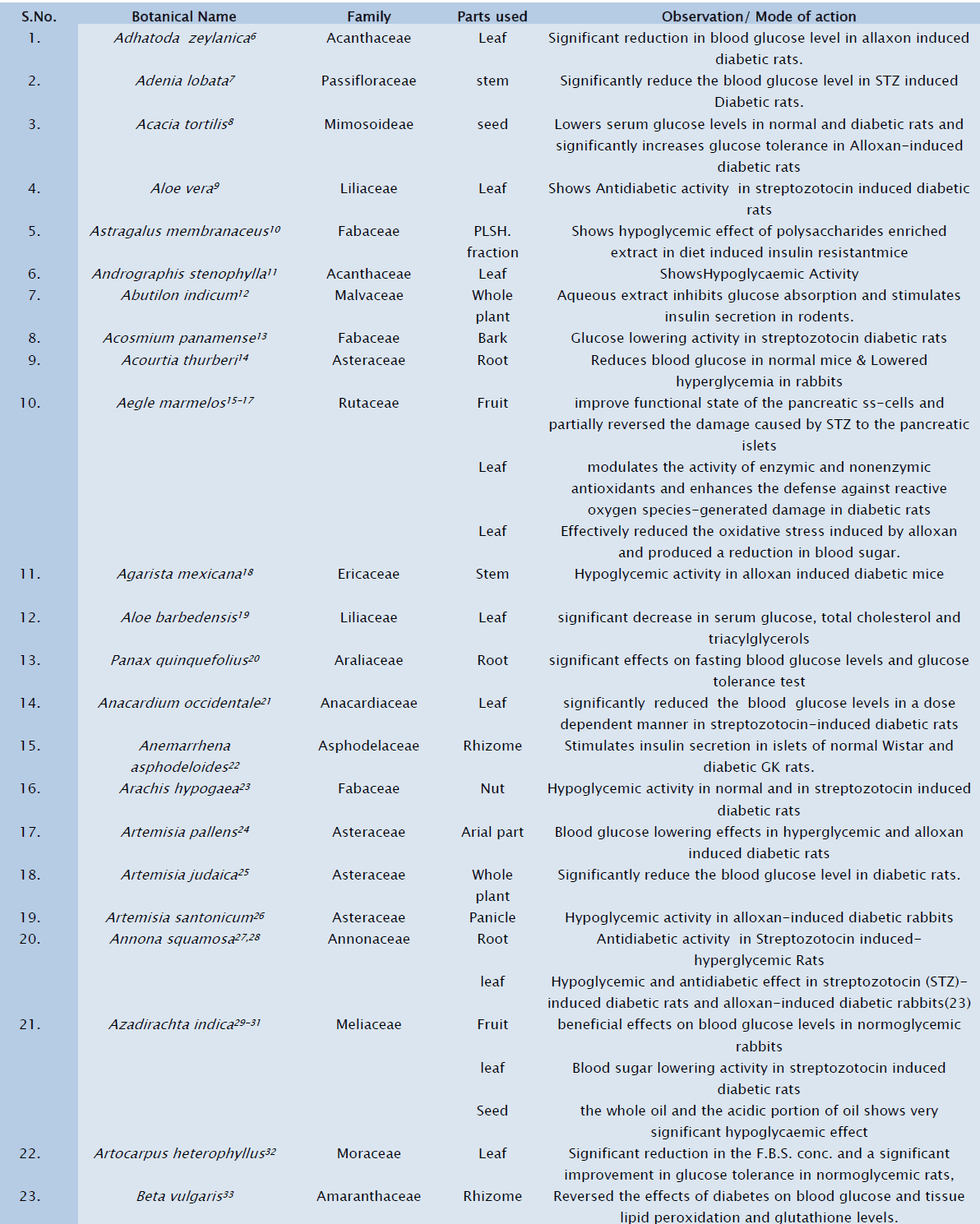
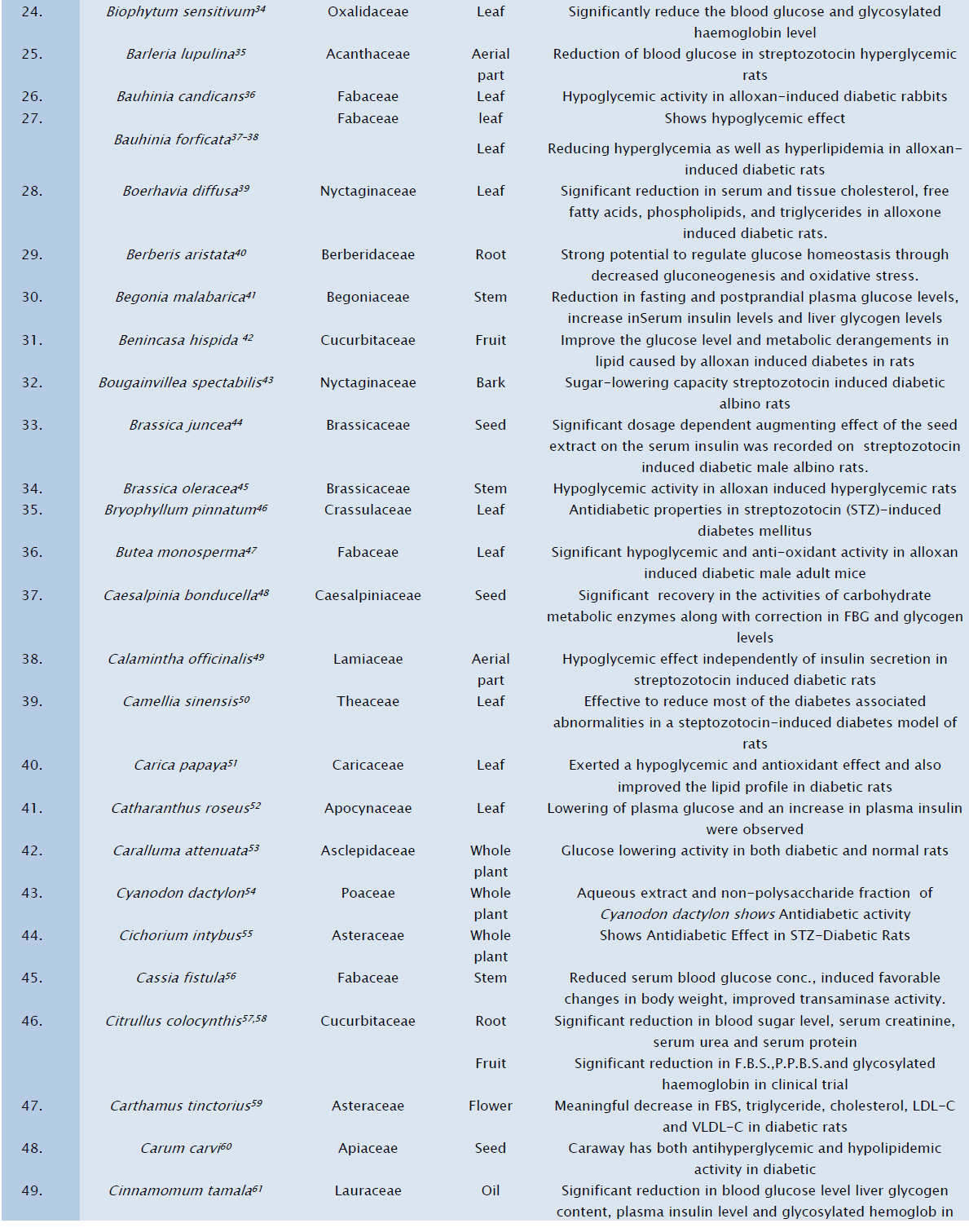
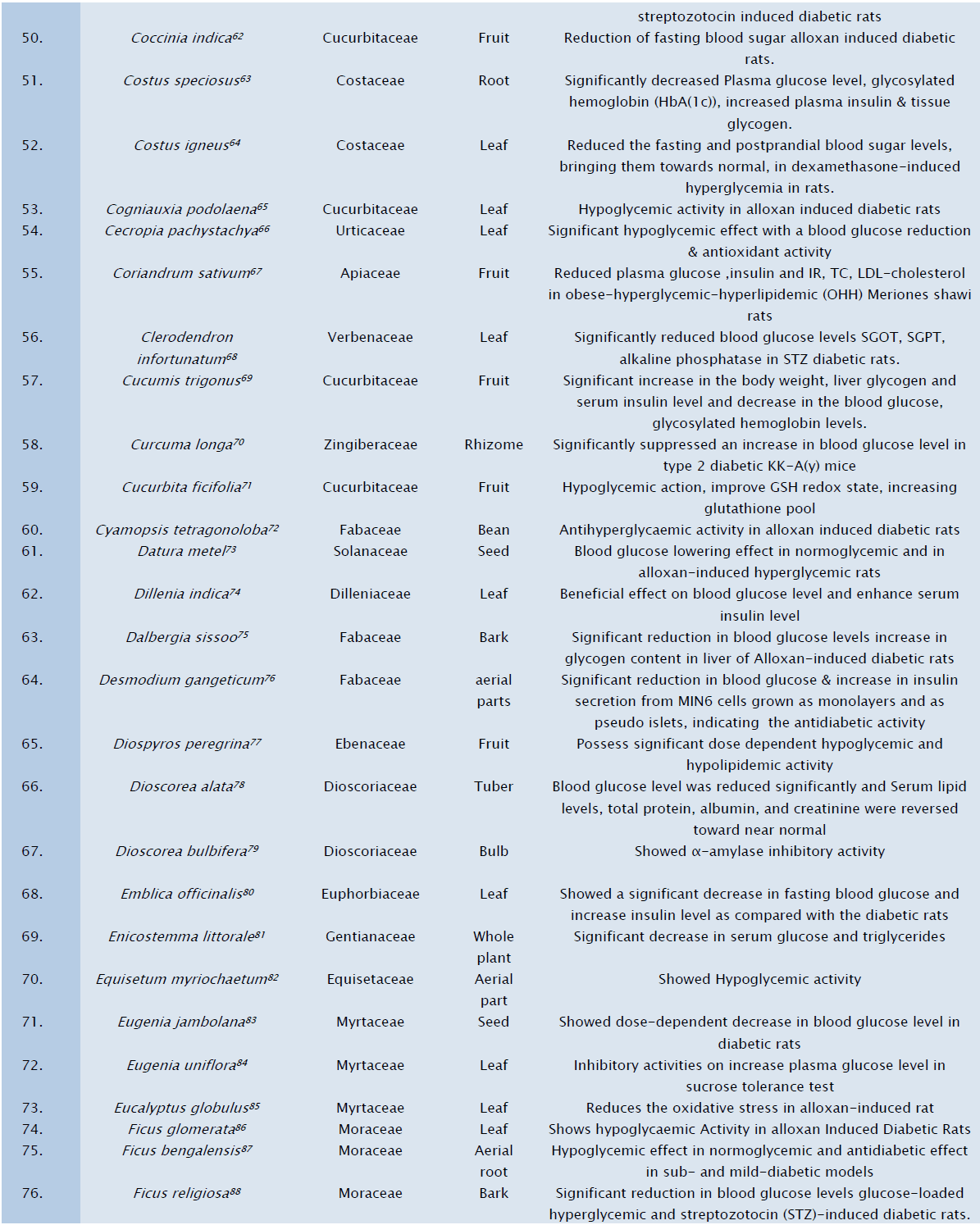
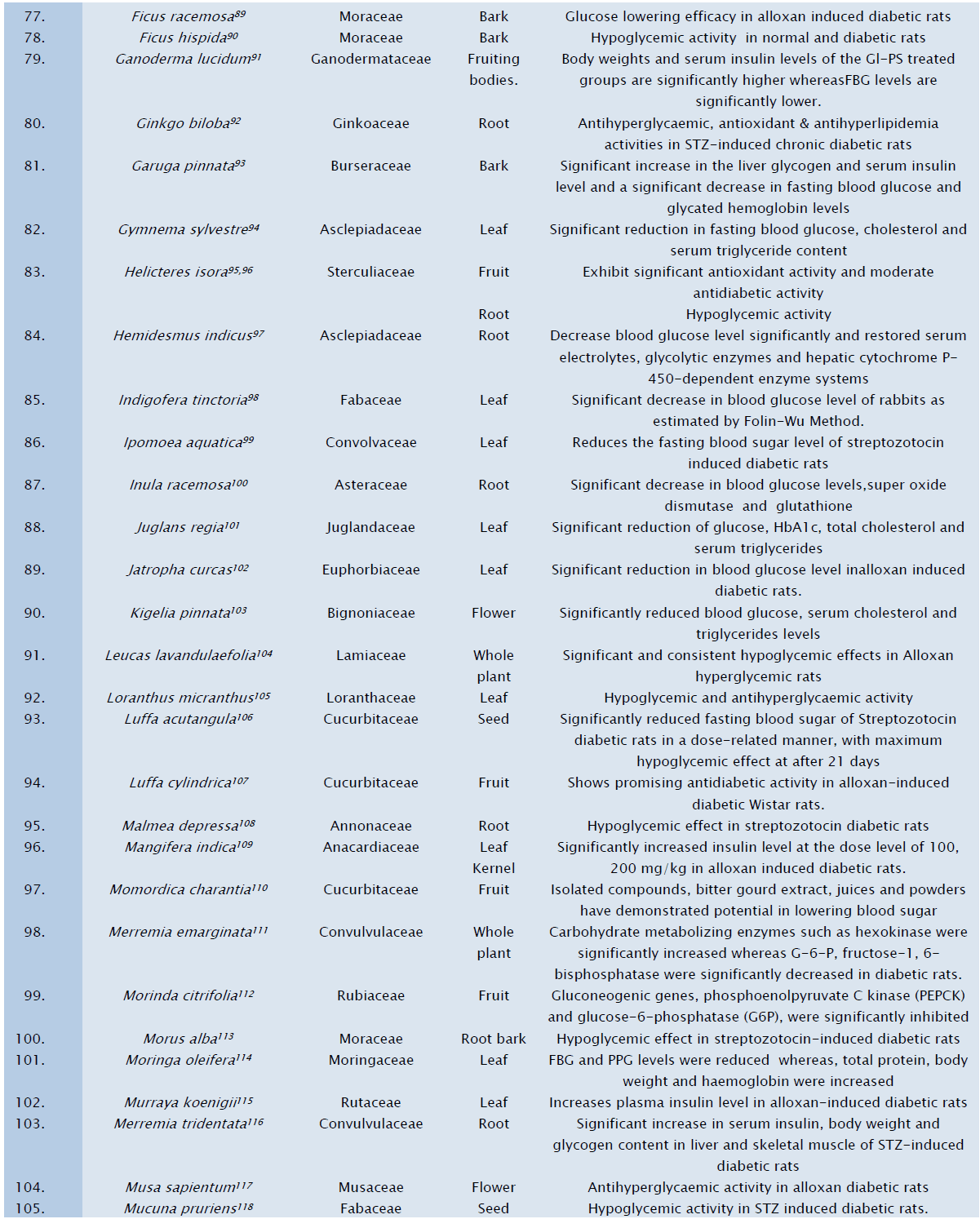
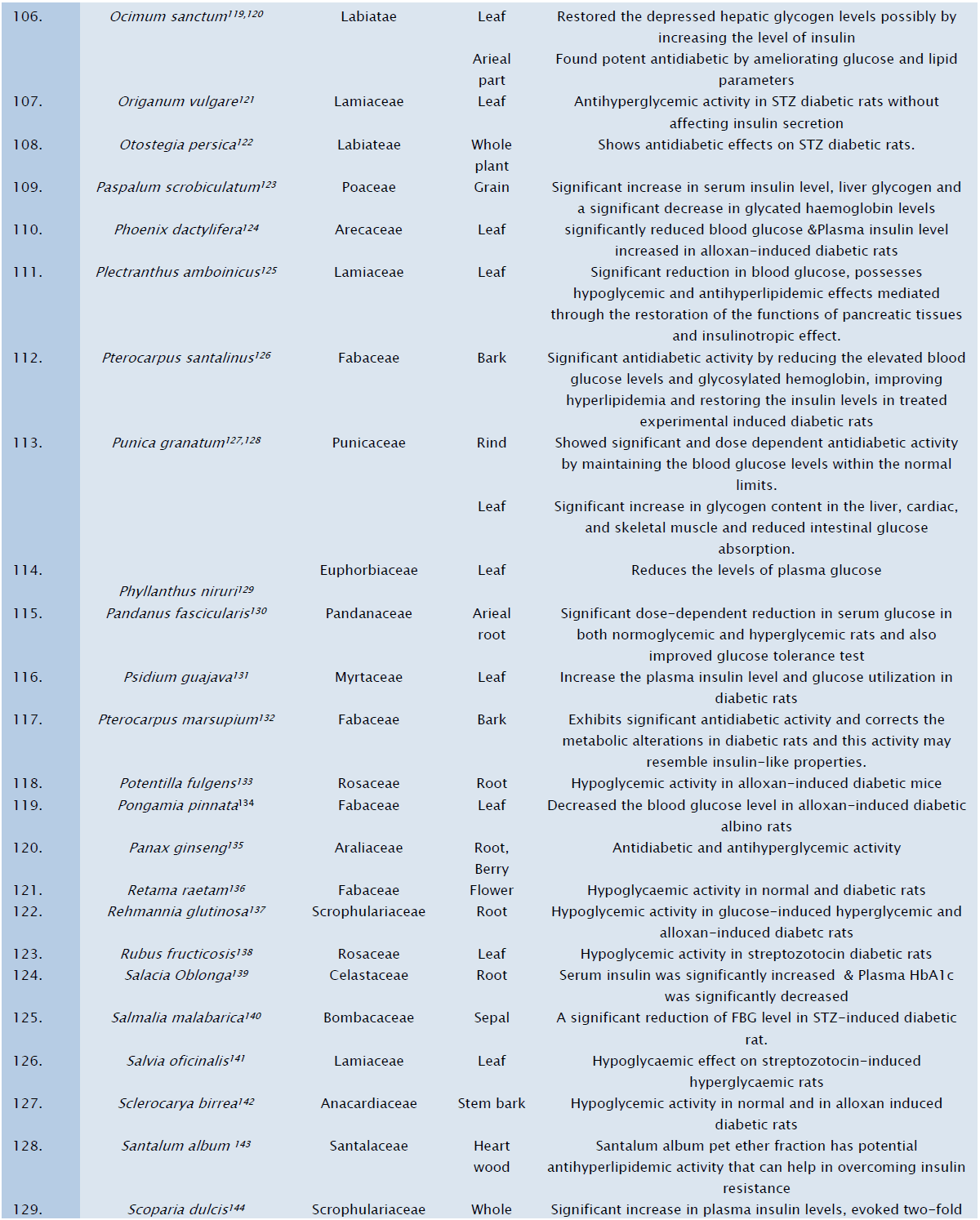
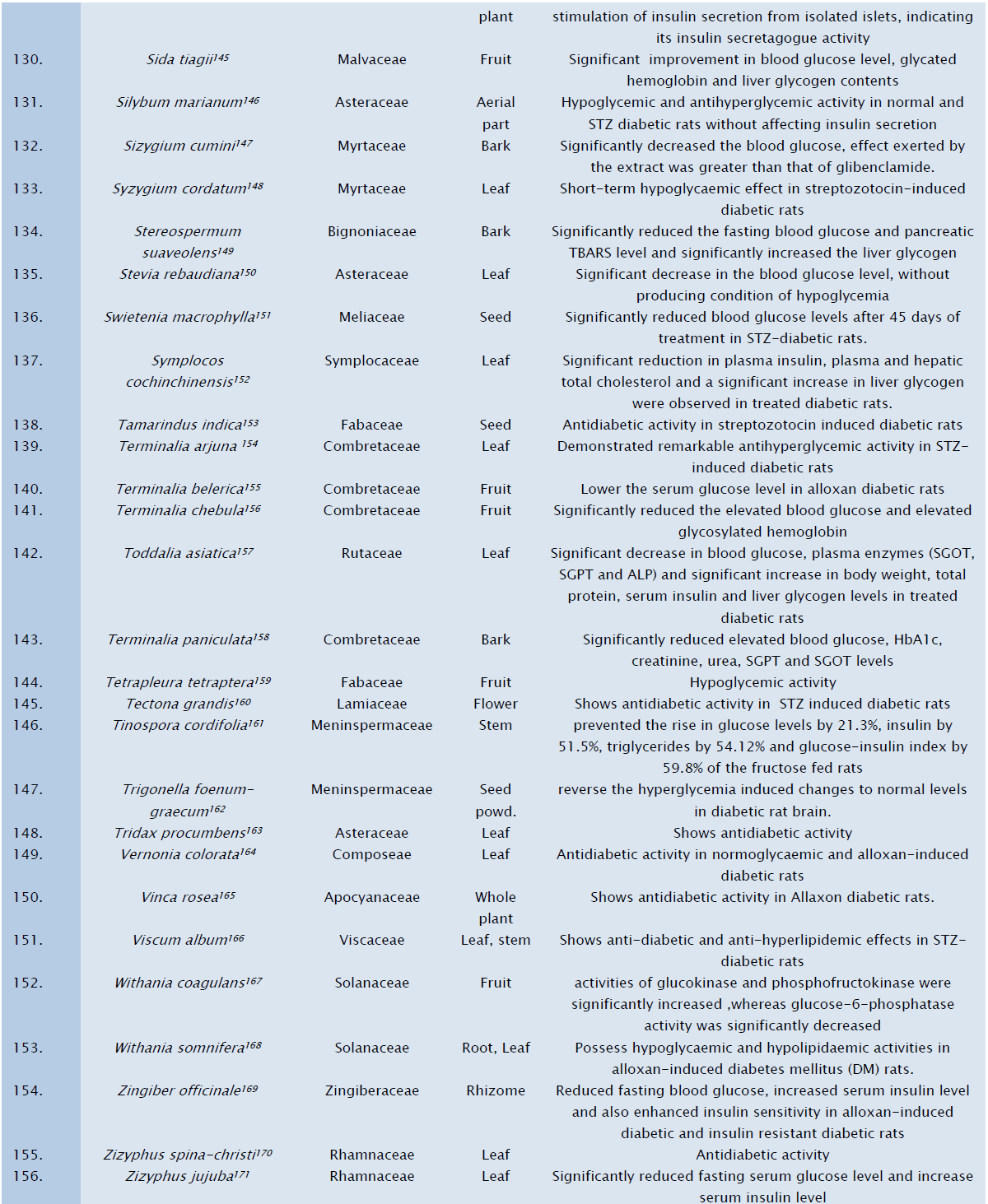
Conclusion
Plant products can be used as adjuvants or even may replace the synthetic drugs in the antidiabetic treatment, as they have no proven side effects and they can help reduce the costs associated with the treatment. By putting a bird’s eye view on aforesaid plants, we found that lots of researches were carried out on plants having potent antidiabetic potential to establish their pharmacological activity and mechanism of action. During the management of diabetes by keeping every possibility of mechanism of each drug provides a basic knowledge for a compound formulation. Still most of the pharmacological activities were limited to animal model; hence clinical trial of individual as well as compound formulation should be conducted in order to establish the safety and effectiveness of above said claim. This review can be used as ready reckoner for further research as well as clinical purpose.
References
- Anthony F.S., Braunwald E., Kasper D.L.,Hauser H.L., Longo D.L.,Jomeson J.L.,Coscaz J., Harrison’s Principles of Internal Medicine, 17 th edition,Mc Graw Hill Publication, 2008; p2275.
- Colagiuri R. Diabetes: A pandemic, a development issue or both? Expert Rev Cardiovasc Ther. 2010; 8:305–9.
- Rang H.P. and Dale M.M., The Endocrine System Pharmacology, 2nd ed. Harlow, UK, Longman, 1991; p504
- Oliver B.B., Oral hypoglycemic action of medicinal plants in tropical West Africa. Cambridge University Press, London, 1986;245-267
- Rai M.K., A review on some antidiabetic plants of India, Ancient Science of Life., 1995;14:42-54
- Bhatt et al.,Phytochemical investigation and antidiabetic activity of Adhatoda zeylanica ,Asian J Pharm Clin Res, 2011;4( 2): 2730
- Sarkodie et al.,Antihyperglycaemic activity of ethanolic extract of the stem of Adenia lobata engl (passifloraceae) IJPSR, 2013; 4(4): 1370-1377.
- Antidiabetic effects of Acacia tortilis seed extract in normal and alloxan-induced diabetic rats- Agrawal et al., IJPSR, 2014;(4): 1392-1397.
- Noor1 A., Gunasekaran S., Soosai A. M., and Vijayalakshmi1 M. A. Antidiabetic activity of Aloe vera and histology of organs in streptozotocin induced diabetic rats, Current Science,2008; 94 : 8( 25 )
- Mao X. et al., Hypoglycemic effect of polysaccharides enriched extract of Astragalus membranaceus in diet induced insulin resistant C57BL/6J mice and its potential mechanism. Phytomedicine 2009;16:416-25
- Parasuraman S., Sankar N., Chandrasekar T., Murugesh K., Neelaveni T.. Phytochemical Analysis and Oral Hypoglycemic Activity of Leaf Extract of Leaves of Andrographis Stenophylla C.B. Clarke (Acanthaceae), IJABPT, 2010;I(2):442-448
- Krisanapun C., Peungvicha P., Temsiririrkkul R., Wongkrajang Y. Aqueous extract of Abutilon indicum Sweet inhibits glucose absorption and stimulates insulin secretion in rodents. Nutr Res2009;29 : 579–87.
- Cetto A.A. and H. Wiedenfeld. Hypoglycemic effect of Acosmium panamense bark on streptozotocin diabetic rats, J. Ethnopharmacology,2004; 90: 217-220
- Aguilar F.J.A., Ramos R.R., Estrada M.J., Chilpa R.R., Peredes B.G. and Flores S.J.L. Effects of three Mexican medicinal plants (Asteraceae) on blood glucose levels on healthy mice and rabbits, J. Ethnopharmacology,1997; 55: 171-177
- Kamalakkannan N. and Prince P.S.,The effect of Aegle marmelos fruit extract in streptozotocin diabetes: a histopathological study, J Herb Pharmacother, 2005;5(3):87-96
- Narendhirakannan R.T. and Subramanian S., Biochemical evaluation of the protective effect of Aegle marmelos (L.), Corr. leaf extract on tissue antioxidant defense system and histological changes of pancreatic beta-cells in streptozotocin-induced diabetic rats, Drug Chem Toxicol, 2010; 33(2):120-30.
- Kuttan R. and M.C. Sabu. Antidiabetic activity of Aegle marmelos and its relationship with its antioxidant properties, Ind. J. Physiol. Pharmacology,2004; 48 (1): 81-88
- Perez G.R.M. and S.R. Vargas. Triterpenes from Agarista mexicana as potential antidiabetic agents, Phytother. Research,2002;16 (1):55-58
- Mohamad E.A. Antidiabetic, Antihypercholestermic and Antioxidative Effect of Aloe Vera Gel Extract in Alloxan Induced Diabetic Rats, Australian Journal of Basic and Applied Sciences, 2011;5(11): 1321-1327
- Xie J.T. et al.,Anti-diabetic effect of American ginseng may not be linked to antioxidant activity: comparison between American ginseng and Scutellaria baicalensis using an ob/ob mice model, Fitoterapia, 2009 ;80(5):306-11
- Sokeng S.D.et al, Hypoglycemic Effect of Anacardium occidentale L. Methanol Extract and Fractions on Streptozotocin-induced Diabetic Rats, Global Journal of Pharmacology,2007; 1 (1): 01-05
- Hoa N.K., Phan D.V., Thuan N.D., Ostenson C.G. Insulin secretion is stimulated by ethanol extract of Anemarrhena asphodeloides in isolated islet of healthy Wistar and diabetic Goto-Kakizaki Rats, Exp Clin Endocrinol Diabetes. 2004; 112(9):520-5.
- Bilbis L.S., Shehu R.A. and Abubarkar M.G. Hypoglycemic and hypolipidemic effects of aqueous extract of Arachis hypogaea in normal and alloxan induced diabetic rats, Phytomedicine,2002; 9 (6): 553-555
- Subramonian A., Pushpangadan P., Rajasekharan S., Evan D.A., Latha P.G. and Valsaraj R. Effects of Artemisia pallens Wall. on blood glucose levels in normal and alloxan induced diabetic rats, J. Ethnopharmacology,1996; 50 (1): 13-17
- Nofal S.M. et al, Antidiabetic effect of Artemisia judaica Extracts, Research Journal of Medicine and Medical Sciences, 2009;4(1): 42-48,
- Korkmaz H. and Gurdal A. Effect of Artemisia santonicum L. on blood glucose in normal and alloxan-induced diabetic rabbits, Phytother. Research,2002;16 (17): 675-676
- Mujeeb M., Alam K.S.,Momhd A.,Mall A.,Antidiabetic activity of the aqueous extract of Annona Squamosa in Streptozotocin induced- Hyperglycemic Rats.The Pharma Research (T. Pharm. Res.),2009;2: 59-63.
- Watal G., Gupta R.K., Kesari A.N., Murthy P.S., Chandra R. and Tandon V. Hypoglycemic and antidiabetic effect of ethanolic extract of leaves of Annona squamosa L. in experimental animals, J. Ethnopharmacology,2005; 99: 75–81
- Rao A.V. et al, Evaluation of the In Vivo Hypoglycemic Effect of Neem (Azadirachta Indica A.Juss) Fruit Aqueous Extract in Normoglycemic Rabbits ,RJPBCS, 2012;3 (1) : 799-806
- Chattopadhyay R.R., A comparative evaluation of some blood sugar lowering agents of plant origin. J. Ethnopharmacology,1999;67 (3): 367-372
- Koffuor G.A. et al, Hypoglycemic Effects Of Whole And Fractionated Azadirachta Indica (Neem) Seed Oils On Alloxan-Induced Diabetes In New Zealand White Rabbits, Journal of the Ghana Science Association,2011;13(1)
- Chackrewarthy K. et al.,Evaluation of the hypoglycemic and hypolipidemic effects of an ethylacetate fraction of Artocarpus heterophyllus (jak) leaves in streptozotocin-induced diabetic rats, Pharmacogn Mag, 2010 ,6(23):186-90.
- Sener G. et al.,Effects of chard (Beta vulgaris L. var. cicla) extract on oxidative injury in the aorta and heart of streptozotocin-diabetic rats, J Med Food., 2002 ;5(1):37-42.
- Ananda Prabu K. et al., Effect of Biophytum sensitivum on streptozotocin and nicotinamide induced diabetic rats ,Asian Pacific Journal of Tropical Biomedicine,2012;31-35
- Suba V., Murugesan T., Rao R.B., Ghosh L., Pal M., Mandal S.C. and Saha B.P. Antidiabetic potential of Barleria lupulina extract in rats, Fitoterapia,2004;75: 1-4
- Fuenter O., Avila P.A. and Alarcon J.. Hypoglycemic activity of Bauhinia candicans in diabetic induced rabbits, Fitoterapia,2004;75: 527-532.
- Cunha A.M., Menon S., Couto A.G., Burger C., Biavatti M.W. Hypoglycemic activity of dried extracts of Bauhinia forficata . Phytomedicine, 2010;17:37-41
- Viana G.S.B., Lino C., Diogenes J.P.L.D., Pereira B.A., Faria R.A.P.G., Neto M.A., Alves R.S., de Queiroz M.G.R. and de Sousa F.C.J. Antidiabetic activity of Bouhinia forficata extracts in alloxan diabetic rats, Biol. Pharm. Bulletin,2004; 27 (1): 125-127
- Pari L. and M.A. Satheesh., Antidiabetic activity of Boerhavia diffusa L. effect on hepatic key enzymes in experimental diabetes, J. Ethnopharmacology,2004;91: 109-113
- Singh J, Kakkar P. Antihyperglycemic and antioxidant effect of Berberis aristata root extract and its role in regulating carbohydrate metabolism in diabetic rats. J Ethnopharmacol 2009; 123:22-6.
- Pandikumar P., Babu N.P., Ignacimuthu S., Hypoglycemic and antihyperglycemic effect of Begonia malabarica Lam. in normal and streptozotocin induced diabetic rats. J Ethnopharmacol, 2009;124:111-5
- Patil R.N., Patil R.Y., Ahirwar D. Study of some medicinal plants for antidiabetic activity in alloxan induced diabetes rats. Pharmacologyonline,2010; 1: 53-60.
- Purohit A. and Sharma A., Antidiabetic efficacy of Bougainvillea spectabilis bark extract in streptozotocin induced diabetic rats, J. Cell and Tissue Research,2006; 6 (1): 537-540
- Thirumalai T. et al.,Hypoglycemic effect of Brassica juncea (seeds) on streptozotocin induced diabetic male albino rat, Asian Pac J Trop Biomed.,2011;1(4): 323–325.
- Koti B.C., Maddi V.S., Jamakandi V.G. and Patil P.A., Effect of crude petroleum ether extract of Brassica oleracea on euglycemic and alloxan induced hyperglycemic albino rats, Indian Drugs,2004;41 (1): 54-55
- Ojewole J.A.O.,. Antinociceptive, anti-inflammatory and antidiabetic effects of Bryophyllum pinnatum (Crassulaceae) leaf aqueous extract, J. Ethnopharmacology,2005;100: 310–313
- Sharma N., Garg V. Antidiabetic and antioxidant potential of ethanolic extract of Butea monosperma leaves in alloxan-induced diabetic mice, Indian J Biochem Biophys, 2009;46(1):99-105.
- Jana K., Chatterjee K., Ali K.M., De D., Bera T.K., Ghosh D. Antihyperglycemic and antioxidative effects of the hydro-methanolic extract of the seeds of Caesalpinia bonducella on streptozotocin-induced diabetes in male albino rats, Pharmacognosy Res., 2012; 4(1):57-62
- Lemhadri A., Zeggwagh N.A., Maghrani M., Jouad H., Michal J.B. and Eddouks M. Hypoglycemic effect of Calamintha officinalis Moench. in normal and streptozotocin induced diabetic rats, J. Pharm. Pharmacology,2004;56: 795-799
- Islam M.S., Effects of the aqueous extract of white tea (Camellia sinensis) in a streptozotocin-induced diabetes model of rats, Phytomedicine.,2011;19(1):25-31
- Juarez-Rojop IE et al., Hypoglycemic effect of Carica papaya leaves in streptozotocin-induced diabetic rats, BMC Complement Altern Med.2012;12:236
- Bellamkonda R et al.,Antihyperglycemic activity of Catharanthus roseus leaf powder in streptozotocin-induced diabetic rats, Pharmacognosy Res.,2010;2(3): 195–201
- Suresh B., Rajkapoor B. and Jayakar B. Effect of Caralluma attenuata in normal and alloxan induced diabetic rats, J. Herbal Pharmacotherapy,2004;4 (1): 35-40
- Jarald EE., Joshi S.B.,Jain D.C., Antidiabetic Activity of aquous extract and non polysaccharide fraction of Cyanodon dactylon Indian Journal of Experimental Biology.,2008;Vol.46(2008): 660-667.
- PusparajP.N., Low H.K.,Maniknandan J.,Tan B.K.H.,. Antidiabetic Effect of Cichorium intybus in Streptozotocin-Diabetic Rats. Journal of Ethnopharmacol,2007;111(2007) : 430
- Daisy P.and Saipriya K., Biochemical analysis of Cassia fistula aqueous extract and phytochemically synthesized gold nanoparticles as hypoglycemic treatment for diabetes mellitus, Int J Nanomedicine,2012; 7: 1189–1202.
- Agarwal V., Sharma A.K., Upadhyay A., Singh G., Gupta R.,Hypoglycemic effects of Citrullus colocynthis roots, Acta Pol Pharm.,2012 ;69(1):75-9.
- Behera B., Yadav D. and Sharma M.C.,Effect of an Herbal Fromulation (Indrayanadi Yog) on Blood Glucose Level, International Research Journal of Biological Sciences,2013;2(4):67-71
- Asgary S., Rahimi P., Mahzouni P. and Madani H.,Antidiabetic effect of hydroalcoholic extract of Carthamus tinctorius L. in alloxan-induced diabetic rats, J Res Med Sci.,2012 ;17(4):386-92.
- Haidari F., Seyed-Sadjadi N., Taha-Jalali M., Mohammed-Shahi M.,The effect of oral administration of Carum carvi on weight, serum glucose, and lipid profile in streptozotocin-induced diabetic rats, Saudi Med J.,2011;32(7):695-700.
- Kumar S., Vasudeva N. and Sharma S.,GC-MS analysis and screening of antidiabetic, antioxidant and hypolipidemic potential of Cinnamomum tamala oil in streptozotocin induced diabetes mellitus in rats, Cardiovasc Diabetol. 2012 ;11:95.
- Ramakrishnan M. et al., Hypoglycemic activity of Coccinia india Wight & Arn. Fruits in Alloxan-induced diabetic rats, Indian Journal of Natural Products and Resources,2011; 2(3):350-353
- Eliza J., Daisy P., Ignacimuthu S., Duraipandiyan V.,Antidiabetic and antilipidemic effect of eremanthin from Costus speciosus (Koen.)Sm., in STZ-induced diabetic rats, Chem Biol Interact.2009; 182(1):67-72.
- Shetty A. et al.,Effect of the insulin plant (Costus igneus) leaves on dexamethasone-induced hyperglycemia, Int J Ayurveda Res. 2010; 1(2): 100–102.
- Diatewa M., Samba C.B., Assah T.C.H., and Abena A.A., Hypoglycemic and antihyperglycemic effects of diethyl ether fraction isolated from the aqueous extract of the leaves of Cogniauxia podolaena Baillon in normal and alloxan-induced diabetic rats, J. Ethnopharmacology,2004;92: 229-232
- Aragao D.M., Guarize L., Lanini J., da Costa J.C., Garcia R.M., Scio E.,Hypoglycemic effects of Cecropia pachystachya in normal and alloxan-induced diabetic rats, J Ethnopharmacol. 2010;128(3):629-33.
- Aissaoui A., Zizi S., Israili Z.H., Lyoussi B.,Hypoglycemic and hypolipidemic effects of Coriandrum sativum L. in Meriones shawi rats, J Ethnopharmacol. 2011; 137(1):652-61.
- Das S. et al.,Preclinical evaluation of antihyperglycemic activity of Clerodendron infortunatum leaf against streptozotocin-induced diabetic rats, Diabetes Ther., 2011; 2(2):92-100.
- Salahuddin M., Jalalpure S.S.,Antidiabetic activity of aqueous fruit extract of Cucumis trigonus Roxb. in streptozotocin-induced-diabetic rats, J Ethnopharmacol. 2010; 127(2):565-7.
- Kuroda M. et al., Hypoglycemic effects of turmeric (Curcuma longa L. rhizomes) on genetically diabetic KK-Ay mice, Biol Pharm Bull. 2005; 28(5):937-9.
- Diaz-Flores M. et al., Effect of an aqueous extract of Cucurbita ficifolia Bouche on the glutathione redox cycle in mice with STZ-induced diabetes, J Ethnopharmacol. 2012; 144(1):101-8.
- Mukhtar H.M., Ansari S.H., Ali M., Bhat Z.A. and Naved T. Effect of aqueous extract of Cyamopsis tetragonoloba Linn. beans on blood glucose level in normal and alloxan-induced diabetic rats, Ind. J. Exp. Biology ,2004;42 (12):1212-1215
- Annapurna A., Koteswara N.R., Krishna R.R.V., Kota M.K., Nammi S. and Murthy B.K., Evaluation of hypoglycemic and antihyperglycemic effects of Datura metel (Linn) seeds in normal and alloxan-induced diabetic rats, J. Ethnopharmacology,2004;91: 95-98
- Kumar S., Kumar V., Prakash O., Antidiabetic, hypolipidemic and histopathological analysis of Dillenia indica (L.) leaves extract on alloxan induced diabetic rats. Asian Pac J Trop Med,2011; 4(5):347-352.
- Vyawahare N.S. et al.,Antidiabetic Evaluation of Dalbergia Sissoo against alloxan induced diabetes mellitus in wistar albino rats,J. Nat. Prod. Plant Resour., 2012; 2 (1): 81-88
- Govindarajan R., Asare-Anane H., Persaud S., Jones P., Houghton P.J.,Effect of Desmodium gangeticum extract on blood glucose in rats and on insulin secretion in vitro,Planta Med., 2007; 73(5):427-32
- Dewanjee S., Das A.K., Sahu R., Gangopadhyay M.,Antidiabetic activity of Diospyros peregrina fruit: effect on hyperglycemia, hyperlipidemia and augmented oxidative stress in experimental type 2 diabetes, Food Chem Toxicol., 2009; 47(10):2679-85
- Maithili V., Dhanabal S.P., Mahendran S., Vadivelan R.,Antidiabetic activity of ethanolic extract of tubers of Dioscorea alata in alloxan induced diabetic rats, Indian J Pharmacol., 2011;43(4):455-9
- Chopade B.A. et al.,Antidiabetic Activity of Gnidia glauca and Dioscorea bulbifera :Potent Amylase and Glucosidase Inhibitors, Evidence-Based Complementary and Alternative Medicine,2012; Article ID 929051, 1-10
- Nain P., Saini V., Sharma S., Nain J., Antidiabetic and antioxidant potential of Emblica officinalis Gaertn. leaves extract in streptozotocin-induced type-2 diabetes mellitus (T2DM) rats. J Ethnopharmacol. 2012; 142(1):65-71
- Vishwakarma S.L., Sonawane R.D., Rajani M., Goyal R.K., Evaluation of effect of aqueous extract of Enicostemma littorale Blume in streptozotocin-induced type 1 diabetic rats, Indian J Exp Biol., 2010; 48(1):26-30.
- Revilla M.C., Cetto A.A., Islas S. and Wiedenfeld H., Hypoglycemic effect of Equisetum myriochaetum aerial parts on type-2 diabetic patients, J. Ethnopharmacology,2002;81 (1): 117-120
- Chaturvedi A., Bhawani G., Agarwal P.K., Goel S., Singh A., Goel R.K., Antidiabetic and antiulcer effects of extract of Eugenia jambolana seed in mild diabetic rats: study on gastric mucosal offensive acid-pepsin secretion, Indian J Physiol Pharmacol. 2009;53(2):137-46.
- Matsumura T., Kasai M., Hayashi T., Arisawa M.Y., Arai I., Amagaya S. and Komatsu Y. A glucosidase inhibitors from Paraguanyan natural medicine, Nangapiry, the leaves of Eugenia uniflora,Pharmaceutical Biology,2000; 38 (4): 302-307
- Ahlema S., Khaleda H., Wafaa M., Sofianeb B., Mohameda D., Claude M.J., Oral administration of Eucalyptus globulus extract reduces the alloxan-induced oxidative stress in rat. Chem Biol Interact,2009; 181: 71-76
- Sharma V.K., Kumar S.,Patel H., Hypoglycemic Activity of Ficus glomerata in Alloxan Induced Diabetic Rats, International Journal of Pharmaceutical Sciences Review and Research,2010;1(2) :18-22.
- Singh R.K., Mehta S., Jaiswal D., Rai P.K., Watal G., Antidiabetic effect of Ficus bengalensis aerial roots in experimental animals, J Ethnopharmacol. 2009; 123(1):110-4.
- Pandit R., Phadke A., Jagtap A., Antidiabetic effect of Ficus religiosa extract in streptozotocin-induced diabetic rats, J Ethnopharmacol. 2010; 128(2):462-6.
- Bhaskara R.R., Murugesn T., Sinha S., Saha B.P., Pal M. and Mandal S.S., Glucose lowering efficacy of Ficus racemosa bark extract in normal and alloxan diabetic rats, Phytother. Research,2002; 16 (6): 590-592
- Ghosh, R., K.H. Sharatchandra, S. Rita and I.S. Thokchom. 2004. Hypoglycemic activity of Ficus hispida (bark) in normal and diabetic albino rats, Ind. J. Pharmacology 36 (4): 222-225
- Li F., Zhang Y. and Zhong Z. Antihyperglycemic Effect of Ganoderma Lucidum Polysaccharides on Streptozotocin-Induced Diabetic Mice, Int J Mol Sci. 2011; 12(9): 6135–6145.
- Cheng D., Liang B., Li Y., Antihyperglycemic Effect of Ginkgo biloba Extract in Streptozotocin-Induced Diabetes in Rats, Biomed Res Int. 2013;2013:162724.
- Shirwaikar A., Rajendran K., Barik R.,Effect of aqueous bark extract of Garuga pinnata Roxb. in streptozotocin-nicotinamide induced type-II diabetes mellitus, J Ethnopharmacol. 2006; 107(2):285-90.
- Mishra P.K. et al.,Antidiabetic and Hypolipidemic Activity of Gymnema sylvestre inAlloxan Induced Diabetic Rats, Global J. Biotech. & Biochem.,2009; 4 (1): 37-42,
- Suthar M., Rathore G. S. and Pareek A. Antioxidant and Antidiabetic Activity of Helicteres isora (L.) Fruits, Indian J Pharm Sci. 2009; 71(6): 695–699
- Venkatesh S., Dayanand R.G., Reddy Y.S., Sathyavathy D. and Madhava R.B. Effect of Helicteres isora root extracts on glucose tolerance in glucose-induced hyperglycemic rats, Fitoterapia,2004; 75 (3-4): 364-367
- Gayathri M., Kannabiran K.,Hypoglycemic activity of Hemidesmus indicus R. Br. on streptozotocin-induced diabetic rats, Int J Diabetes Dev Ctries. 2008; 28(1):6-10.
- Verma S.M.,Suresh K.B.,Verma A.,Antidiabetic Activity of Leaves of Indigofera tinctoria Linn (Fabaceae). International Journal of Toxicological and Pharmacological Research,2010; 1(2): 42-43
- Malalavidhane T.S., Wickramasinghe S.M.D.N., Perera M.S.A. and Jansz E.R. Oral hypoglycemic activity of Ipomoea aquatica in streptozotocin induced diabetic wistar rats and type-II diabetes, Phytother. Research,2003;17 (9): 1098-1100
- Ajani et al.,Evaluation of antidiabetic effect of methanolic extract of Inula racemosa root in rats,Pharmacologyonline,2009; 3: 118-129
- Jamshid M. et al.The effect of hydro alcoholic extract of Juglans regia leaves in streptozotocin-nicotinamide induced diabetic rats,Pak. J. Pharm. Sci., 2012; 25(2): 407-411
- Mishra S.B. et al., Antidiabetic effect of Jatropha curcas Leaves extract in normal and alloxan-induced diabetic rats, Int.J.Ph.Sci.,2010;2(1): 482-487
- Kumar S., Kumar V., Prakash O.,Antidiabetic and hypolipidemic activities of Kigelia pinnata flowers extract in streptozotocin induced diabetic rats, Asian Pac J Trop Biomed. 2012; 2(7):543-6.
- Chandrashekar K. S.and Prasanna K. S., Hypoglycemic effect of Leucas lavandulaefolia willd in alloxan-induced diabetic rats. J Young Pharmacists, 2009;1:326-9
- Osadebe P.O., Okido G.B. and Akabogu I.C., Study on antidiabetic activities of crude methanolic extracts of Loranthus micranthus (Linn) sourced from five different host trees, J. Ethnopharmacology,2004; 95: 133-138
- Mohan R.S. et al.,Antidiabetic Effect of Luffa acutangula Fruits and Histology of Organs in Streptozotocin Induced Diabetic in Rats, Research Journal of Pharmacognosy and Phytochemistry,2012; 4(2):64-69
- Kundusen S. et al.,Evaluation of hypoglycemic and antihyperglycemic effects of Luffacylindrica fruit extract in rats, Journal of Advanced Pharmacy Education & Research,2011; 2: 138-146
- Cetto A.A., Zurita E.M. and Wiedenfeld H., Hypoglycemic effect of Malmea depressa root on streptozotocin diabetic rats, J. Ethnopharmacology,2005;100: 319–322
- Petchi R.et al., Antidiabetic effect of kernel seeds extract of Mangifera indica (Anacardiaceae), International Journal of Pharma and Bio Sciences,2011; 2(1):385-393
- Izharul H. and Khatoon S.,Effect of momordica charantia (bitter gourd) tablets indiabetes mellitus: Type 1 and Type 2 , Prime Research on Medicine,2012; 2(2): 72-74
- Gandhi G.R., Sasikumar P.,Antidiabetic effect of Merremia emarginata Burm. F. in streptozotocin induced diabetic rats.,Asian Pac J Trop Biomed. 2012; 2(4):281-6
- Nerurkar P.V., Nishioka A., Eck P.O., Johns L.M., Volper E., Nerurkar V.R.,Regulation of glucose metabolism via hepatic forkhead transcription factor 1 (FoxO1) by Morinda citrifolia (noni) in high-fat diet-induced obese mice, Br J Nutr., 2012;108(2):218-28.
- Fukai T., El-Beshbishy H.A., Yonekawa M., Nomurac T. and Singab A.N.B., Hypoglycemic effect of Egyptian Morus alba root bark extract: Effect on diabetes and lipid peroxidation of streptozotocin-induced diabetic rats, J. Ethnopharmacology,2005; 100: 333–338
- Jaiswal D., Kumar Rai P., Kumar A., Mehta S., Watal G.,Effect of Moringa oleifera Lam. leaves aqueous extract therapy on hyperglycemic rats. J Ethnopharmacol., 2009; 123(3):392-6.
- Vinuthan M.K., Kumar G.K., Ravindra J.P., Prakash J. and Narayana K., Effect of extracts of Murraya koengii leaves on the levels of blood glucose & plasma insulin in alloxan induced diabetic rats, Ind. J. Physiol. Pharmacology,2004; 48 (3): 348-352
- Arunachalam K., Parimelazhagan T.,Antidiabetic activity of aqueous root extract of Merremia tridentata (L.) Hall. f. in streptozotocin-induced-diabetic rats,Asian Pac J Trop Med., 2012; 5(3):175-9.
- Pari L. and Maheswari J.U., Antihyperglycemic activity of Musa sapientum flower: effect on lipid peroxidation in alloxan diabetic rats, Phytother. Research, 2000; 14(2): 136-138.
- Bhaskar A., Vidhya V.G. and Ramya M., Hypoglycemic effect of Mucuna pruriens seed extract on normal and streptozotocindiabetic rats. Fitoterapia ,2008; 79: 539-543.
- Khan M.R.I.,Antidiabetic Effects of the Different Fractions of Ethanolic Extracts of Ocimum sanctum in Normal and Alloxan Induced Diabetic Rats,J. Sci. Res., 2010; 2 (1), 158-168
- Patil R.N., Patil R.Y., Ahirwar B. and Ahirwar D., Isolation and characterization of ant-diabetic component (bioactivity-guided fractionation) from Ocimum sanctum L. (Lamiaceae) aerial part. Asian Pac J Trop Med, 2011; 4(4): 278-282
- Eddouks M., Jouad H., Maghrani M., Zeggwagh N.A. and Lemhadri A., Antihyperglycemic activity of the aqueous extract of Origanum vulgare growing wild in Tafilalet region. J. Ethnopharmacology,2004; 92: 251-256
- EbrahimpurM.R., Khaksar Z., Noorafsan A., Antidiabetic Effect of Otostegia persica Oral Extract on Streptozotocin-Diabetic Rats,Research Journal of Biological Sciences,2009;4(12) :1227-1229.
- Jain S., Bhatia G., Barik R., Kumar P., Jain A., Dixit V.K.,Antidiabetic activity of Paspalum scrobiculatum Linn. in alloxan induced diabetic rats, J Ethnopharmacol. 2010;127(2):325-8.
- Mard S.A., Jalalvand K., Jafarinejad M., Balochi H., Naseri M.K.,Evaluation of the antidiabetic and antilipaemic activities of the hydroalcoholic extract of phoenix dactylifera palm leaves and its fractions in alloxan-induced diabetic rats, Malays J Med Sci., 2010; 17(4):4-13.
- Viswanathaswamy A.H., Koti B.C., Gore A., Thippeswamy A.H., Kulkarni R.V.,Antihyperglycemic and antihyperlipidemic activity of plectranthus amboinicus on normal and alloxan-induced diabetic rats,Indian J Pharm Sci., 2011;73(2):139-45.
- Kondeti V.K., Badri K.R., Maddirala D.R., Thur S.K., Fatima S.S., Kasetti R.B., Rao C.A.,Effect of Pterocarpus santalinus bark, on blood glucose, serum lipids, plasma insulin and hepatic carbohydrate metabolic enzymes in streptozotocin-induced diabetic rats,Food Chem Toxicol., 2010; 48(5):1281-7.
- Jain V., Viswanatha G.L., Manohar D., Shivaprasad H.N.,Isolation of Antidiabetic Principle from Fruit Rinds of Punica granatum, Evid Based Complement Alternat Med. 2012;2012:147202
- Das S., Barman S.,Antidiabetic and antihyperlipidemic effects of ethanolic extract of leaves of Punica granatum in alloxan-induced non-insulin-dependent diabetes mellitus albino rats, Indian J Pharmacol. 2012; 44(2):219-24.
- Bavarva J.H. and Narasimhacharya A.V.R.L., Antidiabetic and antihyperlipidemic effects of ethanolic extract of Phyllanthus niruri L. leaves, J. Cell and Tissue Research ,2005;5 (2): 461-464
- Kumari S., Wanjari M., Kumar P., Palani S. Antidiabetic activity of Pandanus fascicularis Lamk - aerial roots in alloxan-induced hyperglycemic rats. Int J Nutr Pharmacol Neurol Dis, 2012;2:105-10
- Shen S.C., Cheng F.C., Wu N.J.,Effect of guava (Psidium guajava Linn.) leaf soluble solids on glucose metabolism in type 2 diabetic rats. Phytother Res.,2008; 22(11):1458-64.
- Dhanabal S.P., Kokate C.K., Ramanathan M., Kumar E.P., Suresh B.,Hypoglycaemic activity of Pterocarpus marsupium Roxb. Phytother Res., 2006;20(1):4-8.
- Syiem D., Syngai G., Khup P.Z., Khongwir B.S., Kharbuli B. and Kayang H., Hypoglycemic effects of Potentille fulgens L. in normal and alloxan induced diabetic mice, J. Ethnopharmacology,2002;83 (1-2): 55-61
- SikarwarM.S. and PatilM.B., Antidiabetic activity of Pongamia pinnata leaf extracts in alloxan-induced diabetic rats, Int J Ayurveda Res., 2010;1(4): 199–204.
- Dey L., Xie J.T., Wang A., Wu J., Maleckar S.S. and Yuan C.S., Antihyperglycemic effects for ginseng: Comparison between root and berry, Phytomedicine ,2003; 10 (6-7): 600-605
- Maghrani M., Michel J.B. and Eddouks M., Hypoglycaemic activity of Retama raetam in rats, Phytother. Research,2005;19 (2): 125-128
- Zhang R., Zhou J., Jia Z., Zhang Y. and Gu G., Hypoglycemic effect of Rehmannia glutinosa oligosaccharide in hypoglycemic and alloxan induced diabetic rats and its mechanism, J. Ethnopharmacology,2004;90: 39-43
- Jouad H., Maghrani M. and Eddouks M., Hypoglycemic effect of Rubus fructicosis L. and Globularia alypum L. in normal and streptozotocin induced diabetic rats. J. Ethnopharmacology,2002; 81 (3): 351-356
- Bhat B.M., Raghuveer C.V., D’Souza V. and Manj P.A., Antidiabetic and Hypolipidemic Effect of Salacia Oblonga in Streptozotocin Induced Diabetic Rats,Clin Diagn Res. 2012; 6(10): 1685–1687
- De D., Ali K.M., Chatterjee K., Bera T.K., Ghosh D., Antihyperglycemic and antihyperlipidemic effects of n-hexane fraction from the hydro-methanolic extract of sepals of Salmalia malabarica in streptozotocin-induced diabetic rats, J Complement Integr Med. 2012; 21;9:Article 12.
- Eidi M., Eidi A. and Zamanizadeh H., Effect of Salvia offcinalis L. leaves on serum glucose and insulin in healthy and streptozotocin-induced diabetic rats, J. Ethnopharmacology ,2005;100: 310–313
- Ojewole J.A.O., Hypoglycemic effect of Sclerocarya birrea {(A.Rich.) Hochst} [Anacardiaceae] stem bark aqueous extract in rats, Phytomedicine ,2003; 10 (8): 675-681
- Kulkarni C.R., Joglekar M.M., Patil S.B., Arvindekar A.U., Antihyperglycemic and antihyperlipidemic effect of Santalum album in streptozotocin induced diabetic rats, Pharm Biol. 2012; 50(3):360-5.
- Latha M., Pari L., Ramkumar K.M., Rajaguru P., Suresh T., Dhanabal T., Sitasawad S., Bhonde R.,Antidiabetic effects of scoparic acid D isolated from Scoparia dulcis in rats with streptozotocin-induced diabetes, Nat Prod Res. 2009;23(16):1528-40.
- Datusalia A.K., Dora C.P., Sharma S., Acute and chronic hypoglycemic activity of Sida tiagii fruits in N5-streptozotocin diabetic rats, Acta Pol Pharm., 2012; 69(4):699-706.
- Eddouks M., Maghrani M., Zeggwagh N.A., Lemhadri A., El Amraoui M. and Michel J.B., Study of the hypoglycemic activity of Fraxinus excelsior and Silybum marianum in an animal model of type 1 diabetes mellitus, J. Ethnopharmacology ,2004;91: 309-316
- Saravanan G., Leelavinothan P.,Effects of Syzygium Cumini Bark on Blood Glucose, Plasma Insulin and C-peptide in Streptozotocin induced Diabetic rats, Int J Endocrinol Metab, 2006; 4: 96-105
- Musabayane C.T., Mahlalela N., Shode F.O. and Ojewole J.A.O.,. Effects of Syzygium cordatum (Hochst.) [Myrtaceae] leaf extract on plasma glucose and hepatic glycogen in streptozotocin-induced diabetic rats, J. Ethnopharmacology ,2005; 97: 485–490.
- Balasubramanian T., Chatterjee T.K., Senthilkumar G.P., Mani T., Effect of Potent Ethyl Acetate Fraction of Stereospermum suaveolens Extract in Streptozotocin-Induced Diabetic Rats,The ScientificWorld Journal, 2012; Article ID 413196.
- Misra H., Soni M., Silawat N., Mehta D., Mehta B. K., Jain D. C., Antidiabetic activity of medium-polar extract from the leaves of Stevia rebaudiana Bert. (Bertoni) on alloxan-induced diabetic rats. J Pharm Bioall Sci, 2011;3:242-8
- Kalpana K., Pugalendi K.V.,Antioxidative and hypolipidemic efficacy of alcoholic seed extract of Swietenia macrophylla in streptozotocin diabetic rats. J Basic Clin Physiol Pharmacol. 2011; 22(1-2):11-21
- Sunil C., Ignacimuthu S., Agastian P., Antidiabetic effect of Symplocos cochinchinensis (Lour.) S. Moore. in type 2 diabetic rats, J Ethnopharmacol., 2011; 134(2):298-304.
- Ghosh D., Jana D., Maiti R. and Das V.K.,. Antidiabetic effect of aqueous extract of seed of Tamarindus indica in streptozotocin induced diabetic rats, J. Ethnopharmacology,2004; 92: 85-91
- Biswas M., Kar B., Bhattacharya S., Kumar R.B., Ghosh A.K., Haldar P.K.,Antihyperglycemic activity and antioxidant role of Terminalia arjuna leaf in streptozotocin-induced diabetic rats,Pharm Biol. 2011 Apr;49(4):335-40.
- Sabu, M.C. and R. Kuttan. 2002. Antidiabetic and Antioxidant activity of Terminalia belerica Roxb., Indian Journalof Experimental Biology,2009; 47:270-275
- Murali Y.K., Anand P., Tandon V., Singh R., Chandra R., Murthy P.S.,Long-term effects of Terminalia chebula Retz. on hyperglycemia and associated hyperlipidemia, tissue glycogen content and in vitro release of insulin in streptozotocin induced diabetic rats.,Exp Clin Endocrinol Diabetes. 2007; 115(10):641-6.
- Stephen I.S., Sunil C., Duraipandiyan V., Ignacimuthu S.,Antidiabetic and antioxidant activities of Toddalia asiatica (L.) Lam. leaves in streptozotocin induced diabetic rats, J Ethnopharmacol., 2012; 143(2):515-23.
- Ramachandran S., Rajasekaran A., Manisenthilkumar K.,Investigation of hypoglycemic, hypolipidemic and antioxidant activities of aqueous extract of Terminalia paniculata bark in diabetic rats, Asian Pac J Trop Biomed. 2012;2(4):262-8
- Ojewole J.A.O. and Adewunmi C.O., Anti-inflammatory & hypoglycemic effects of Tetrapleura tetraptera (Taub) (Fabaceae) fruit aqueous extract in rats, J. Ethnophramacol,2004; 95: 177-182.
- Ramachandran S., Rajasekaran A., Manisenthil K.T., Antidiabetic, antihyperlipidemic and antioxidant potential of methanol extract of Tectona grandis flowers in streptozotocin induced diabetic rats. Asian Pac J Trop Med,2011; 4(8): 624-631.
- Reddy S.S., Ramatholisamma P., Karuna R., Saralakumari D.,Preventive effect of Tinospora cordifolia against high-fructose diet-induced insulin resistance and oxidative stress in male Wistar rats, Food Chem Toxicol. 2009; 47(9):2224-9.
- Kumar P., Kale R.K., McLean P., Baquer N.Z., Antidiabetic and neuroprotective effects of Trigonella foenum-graecum seed powder in diabetic rat brain, Prague Med Rep., 2012; 113(1):33-43.
- Durgacharan A., Antidiabetic activity of Leaf Extract of Tridax procumbens, International Journal of Green Pharmacy, 2008; 2( 2) : 126-128
- Sy G.Y.A., Cisse A., Nongonierma R.B., Sarr M., Mbodja N.A. and Fayea B., Hypoglycaemic and antidiabetic activity of acetonic extract of Vernonia colorata leaves in normoglycaemic and alloxan-induced diabetic rats, J. Ethnopharmacology,2005;98: 171–175.
- Mohammed F., Mohammed A., Ghori S., Ali S., Antidiabetic Activity of Vinca rosea Extracts in Alloxan-Induced Diabetic Rats,2010.International Journal of Endocrinology Volume 2010 ;Article ID 841090
- Adaramoye O., Amanlou M., Habibi-Rezaei M., Pasalar P., Ali M.M., Methanolic extract of African mistletoe (Viscum album) improves carbohydrate metabolism and hyperlipidemia in streptozotocin-induced diabetic rats, Asian Pac J Trop Med. 2012;5(6):427-33.
- Shukla K., Dikshit P., Shukla R., Gambhir J.K.,The aqueous extract of Withania coagulans fruit partially reverses nicotinamide/streptozotocin-induced diabetes mellitus in rats, J Med Food. 2012; 15(8):718-25.
- Udayakumar R. et al.,Hypoglycaemic and hypolipidaemic effects of Withania somnifera root and leaf extracts on alloxan-induced diabetic rats, Int J Mol Sci. 2009; 10(5):2367-82.
- Iranloye B.O., Arikawe A.P., Rotimi G., Sogbade A.O.,Anti-diabetic and anti-oxidant effects of Zingiber Officinale on alloxan-induced and insulin-resistant diabetic male rats, Niger J Physiol Sci. 2011; 26(1):89-96.
- Abdel-Zaher A.O., Safa Y.S., Mahmoud H.A. and Abdel-Hady R.H., Antidiabetic activity and toxicity of Zizyphus spina-christi leaves, J. Ethnopharmacology ,2005;101: 129–138
- Hussen H.M., Sayed E.M. and Said A.A., Antihyperglycemic,antihyperlipidemic and Antioxidant Effects of Zizyphus spina Christi and Zizyphus jujube in Alloxan diabetic rats., International journal of pharmacology, 2006;, 2(5):563-570





